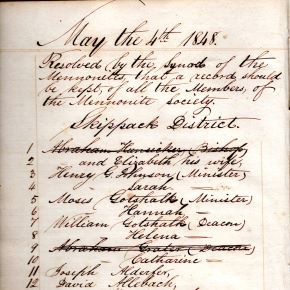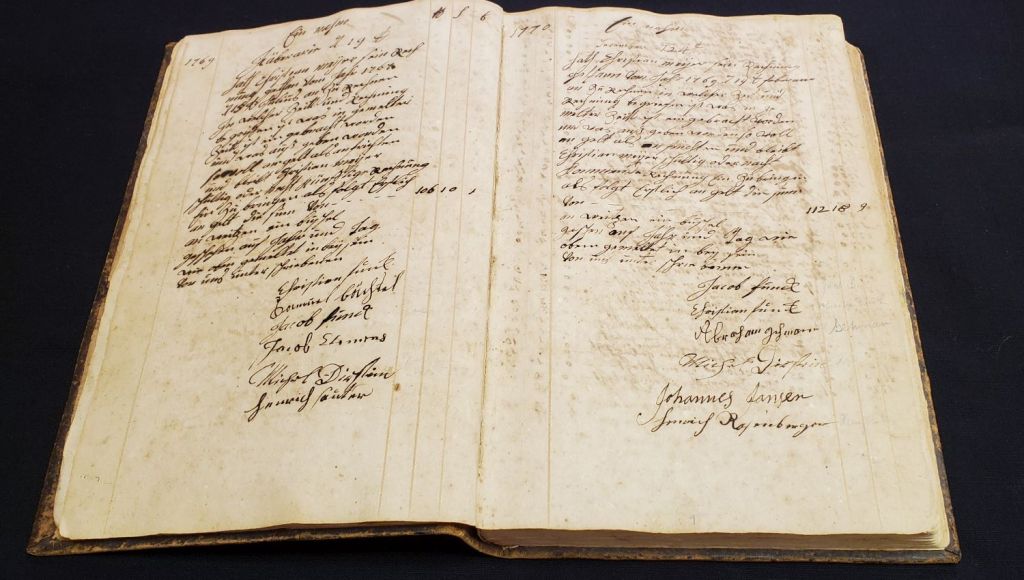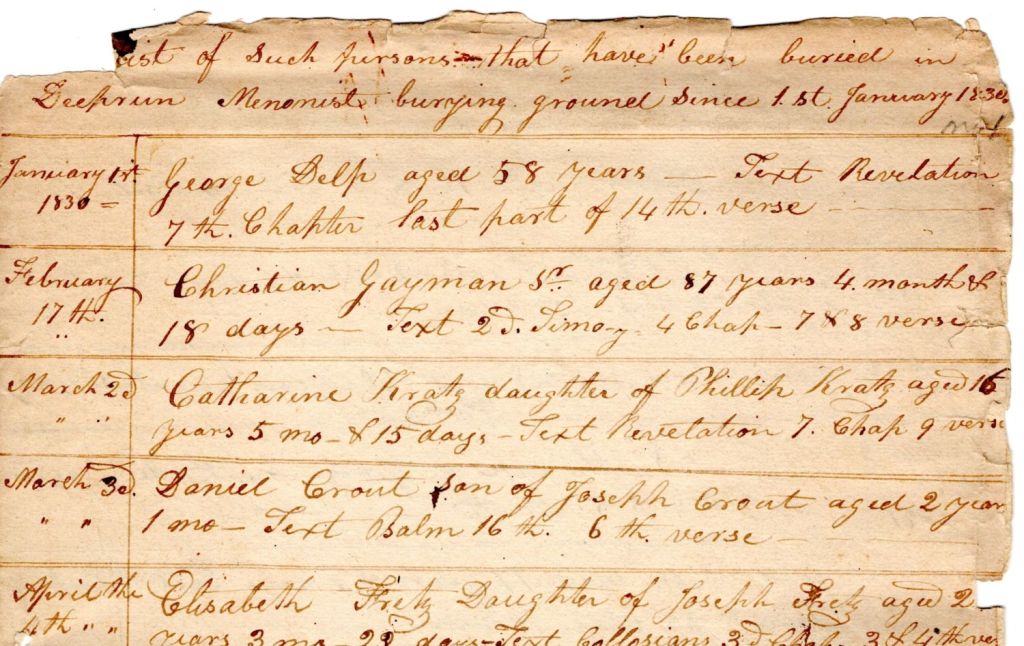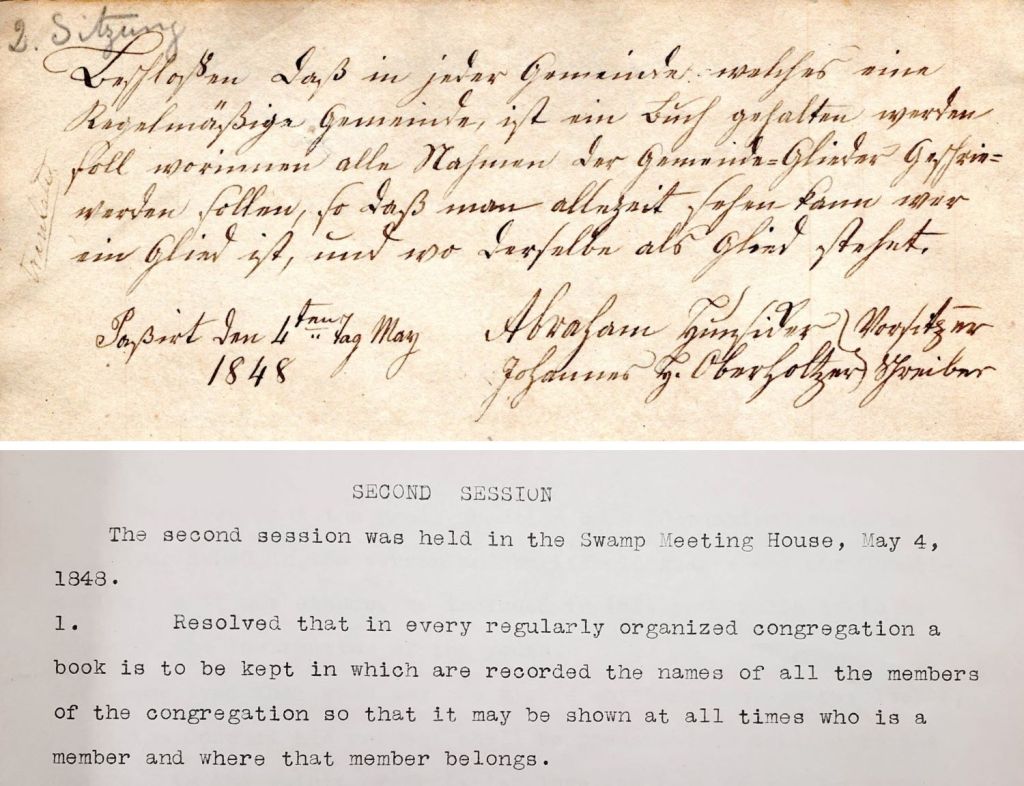Early Mennonite Church Records
Written by Joel Alderfer on March 26, 2021

This article was published in the MHEP Newsletter in November 1995, and has been updated to include church records added to the collection since that time.
Researchers at the MHC Historical Library often ask, “Where are the early Mennonite church records?” or “What church records do you have?”
This is not a simple question. First of all, what does the researcher mean by church records? There are membership, baptismal, ministerial, burial records, alms records, property and land records.
I explain that generally, in Pennsylvania, there were no Mennonite church membership records before 1850. There are church property records, alms records and trustee records going back to the mid-18th century, but these do not contain membership records.

To answer part of this question, I have compiled an inventory of the older (19th and early 20th century) local Mennonite membership records that are in the Historical Library and Archives. By membership records, I mean records of baptisms, burials or funerals, removals and ordinations. I have also included some early congregational minute books and alms records, but have not mentioned the various collections of early property deeds from local Mennonite congregations found in the archives.
Records available at the MHC
Bally Mennonite Church – Membership records, ca. 1897-1962; Alms (Deacon’s) record, 1859-1900.
Blooming Glen Mennonite Church – Membership records, 1889-1965.
Deep Run East Mennonite Church, Perkasie – Membership records, 1859-1891; Burial records, 1830-1906.
Deep Run West Mennonite Church, Perkasie – Membership records, 1853-1920; Congregational Minute Book, 1849-1949.
Doylestown Mennonite Church – Membership records, 1897-1969; Alms record, 1860-1915.
East Swamp Mennonite Church, Quakertown – Membership records, 1848-1888.
Eden Mennonite Church, Schwenksville – Membership records, 1860s-1920.
First Mennonite Church, Allentown – Membership records, 1903-2003.
First Mennonite Church, Philadelphia – Membership records, 1865-1965.
Flatland-Bethany Mennonite Church, Quakertown – Flatland membership records, 1856-1965; Congregational Minute Book, 1890-1957; Bethany membership records, 1899-1965.
Franconia Mennonite Church – Membership records, 1888-1978; Alms record, 1756-1947.
Germantown Mennonite Church, Philadelphia – Minutes, membership and account books, 1770-1838 and 1848-1892 (photocopies, originals at Bluffton University).
Hereford Mennonite Church, Bally – Membership records, 1852-1882.
Line Lexington Mennonite Church – Membership records, 1911-1973; Alms record, 1850-1907; Burial records, 1901-1947.
Lower Skippack Mennonite Church – Membership records, 1848-1975.
Plains Mennonite Church, Hatfield – Membership records, 1907-1964; subscription list for meetinghouse construction, 1813.
Rockhill Mennonite Church – Burial Records, 1864-1903; Alms record, 1866-1963; Trustees records, 1885-1916; Baptismal records, 1924-1956.
Salford Mennonite Church – Membership records, 1890-1980s; Alms record, 1849-1965; Trustees records, 1818-1965.
Second Mennonite Church, Philadelphia – Membership record, 1940; Trustees records, 1899-1905.
Skippack Bishop District – Alms records, 1738-1954 (retained by Upper Skippack congregation after the 1847 division).
Springfield Mennonite Church – Membership records, 1848-1930s.
Swamp Mennonite Church, Quakertown – Membership records, 1919-1987; Subscription lists and meetinghouse construction records, 1847.
Towamencin Mennonite Church – Meetinghouse subscription list, 1805; Trustees records, 1847-.
Upper Milford Mennonite Church – Membership records, 1867-1890s; Church property records and Congregational meeting minutes, 1870s-1890.
Upper Skippack Mennonite Church – Membership records, 1908-1971.
Vincent Mennonite Church – Membership records, 1892-1897 and 1945-1986.
West Swamp Mennonite Church, Quakertown – Membership records, 1848-1961; Congregational Minute Book, 1873- 1934; Meetinghouse subscription and construction records, 1819-20; Trustees records, 1832-1870.
Zion Mennonite Church, Souderton – Membership records, 1893-1998; Annual Meeting minutes, 1893-1997.


Personal ministerial records
Bishop Warren G. Bean, Skippack District (Skippack, Providence, Worcester, Vincent, Bally, Pottstown, Norristown churches in the Franconia Conference). Records of baptisms, ordinations, funerals, worship services, 1897-1946.
Preacher Jacob B. Mensch, Skippack Congregation & Skippack District. Personal Diary, 1880-1911. Includes records of funerals attended, worship meetings, visitors received and visits made.
Preacher I. Frank Swartz, Blooming Glen Congregation, ministerial record or diary, 1908-1935. Baptisms, ordinations, funerals, worship services at Blooming Glen, Deep Run East, Doylestown Mennonite Churches.
Bishop Joseph G. Ruth, Line Lexington Congregation. Records of baptisms and funerals, 1911-1928.


Why are there no membership records before the 1840s?
Perhaps the most significant reason is that Mennonites had a totally different concept of church from the state-church or high-church tradition. In the believer’s church tradition, there was voluntary membership, and those who were members wanted to be members and were committed to the congregation. The church was not seen as an institution, but as a community, or congregation. There were usually many close family ties and interrelationships in Mennonite congregations and members knew one another. There was no perceived need to keep membership records.
In Europe, during the 16th, 17th, and 18th centuries, Mennonites would have associated official record keeping with extra taxation and harassment by the authorities. Therefore, ministers would avoid keeping records of their own congregations.
Traditionally, Mennonite preachers were full-time farmers and tradesmen and who had to work to support themselves. They were not educated more than other members. There may not have been the know-how, the time, or the inclination to keep church membership records.


Why did Mennonites begin to keep records?
It is easier to explain why membership records began in 1848 in some local Mennonite churches.
In 1847, there was a division in this community between progressive (new) and conservative (old) Mennonites. Just one of the issues in this division was the keeping of church records, including a written constitution, and the keeping of minutes at Conference sessions and congregational meetings. At one of the first sessions of the new Eastern Pennsylvania Conference, later the Eastern District Conference, a resolution was made to have all churches in the new Conference start a church membership record book. Thus, by the fall of 1848, most congregations started church membership records. Many of these are in the Historical Library & Archives at the Mennonite Heritage Center. The Franconia Conference congregations generally did not follow suit for forty to sixty years.

